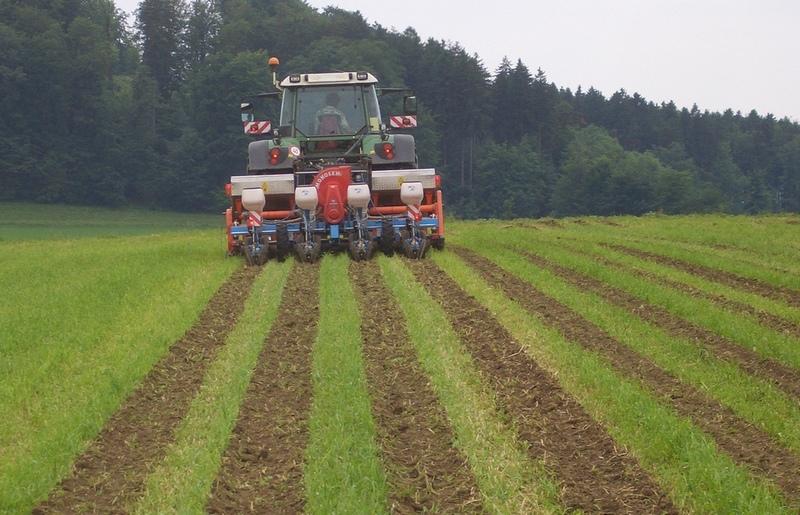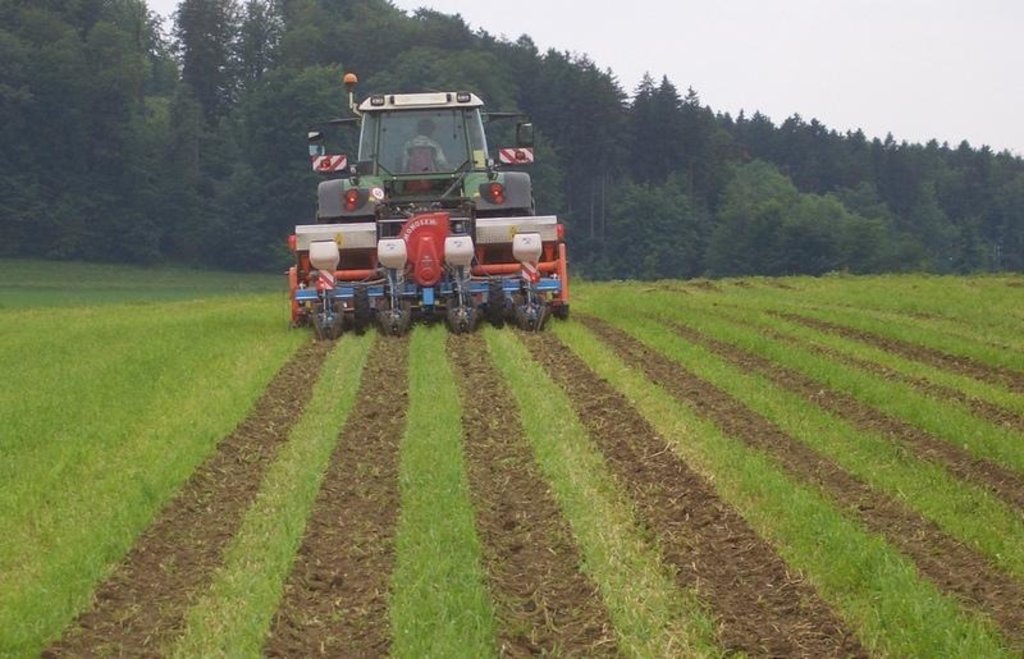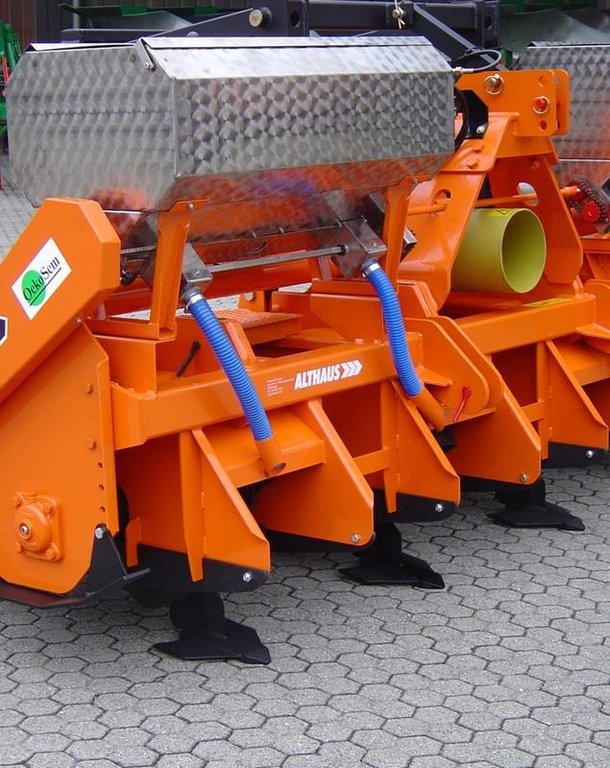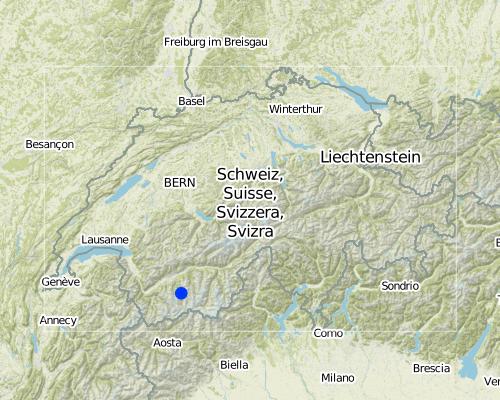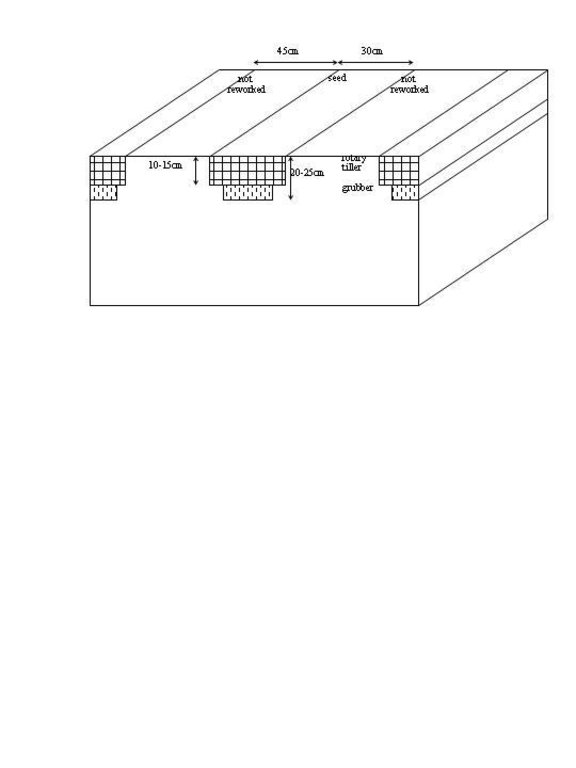Maize strip tillage [瑞士]
- 创建:
- 更新:
- 编制者: Unknown User
- 编辑者: –
- 审查者: Fabian Ottiger
Streifenfrässaat (German)
technologies_1006 - 瑞士
查看章节
全部展开 全部收起1. 一般信息
1.2 参与该技术评估和文件编制的资源人员和机构的联系方式
关键资源人
SLM专业人员:
Wyler Roman
romanwyler@students.unibe.ch
Center for Development and Environment, University of Berne
Hallerstrasse 10, 3012 Bern, Switzerland
瑞士
土地使用者:
Wyss Beat
031 765 52 33
beat_wyss@hotmail.com
Hauptstr. 22, 4588 Oberramsern, Switzerland
瑞士
有助于对技术进行记录/评估的机构名称(如相关)
CDE Centre for Development and Environment (CDE Centre for Development and Environment) - 瑞士1.3 关于使用通过WOCAT记录的数据的条件
(现场)数据是什么时候汇编的?:
09/10/2008
编制者和关键资源人员接受有关使用通过WOCAT记录数据的条件。:
是
1.5 请参阅有关SLM方法的问卷
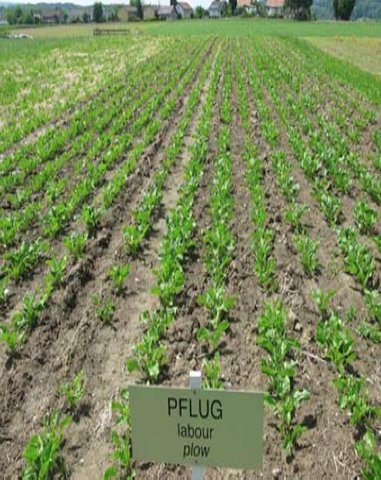
Soil support program for conservation agriculture [瑞士]
Through the soil support program land users get subsidies for applying conservation technologies on their fields during a period of 6 years.
- 编制者: Deborah Niggli
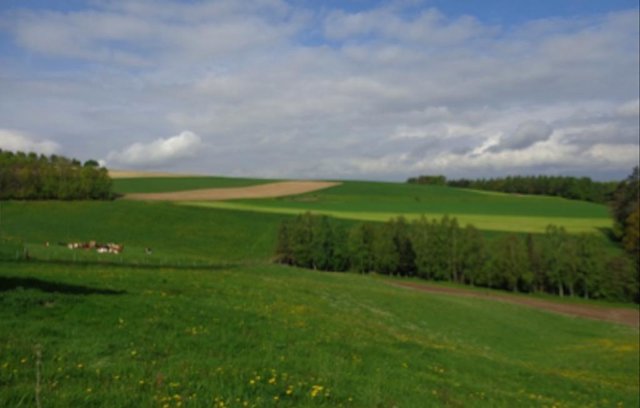
Direktzahlungssystem [瑞士]
Finanzielle Leistungen des Bundes um den Ertragsverlust, den eine Kultur für den Bauern bringt, auszugleichen. Das Direktzahlungssystem führt gewissermassen zu einer 'Vergünstigung des Produkts' für den Konsumenten.
- 编制者: Deborah Niggli
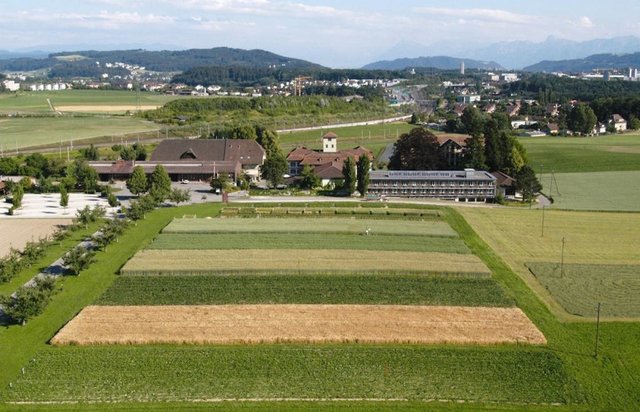
Förderprogramm Boden [瑞士]
Mit dem Förderprogramm Boden des Kantons Bern erhalten beteiligte Landnutzer Direktzahlungen für die Anwendung von bodenkonservierenden Anbauverfahren auf ihren landwirtschaftlichen Feldern. Das Projekt hat eine Dauer von 6 Jahren.
- 编制者: Deborah Niggli
2. SLM技术的说明
2.1 技术简介
技术定义:
A cropping system for maize which reduces the reworking of the soil to the stripes, in which the seeds are planted.
2.2 技术的详细说明
说明:
Maize strip tillage is a mixture between no tillage and conventional agriculture. The reworking of the soil greatly reduced. Instead of ploughing and harrowing a special rotary tiller including a grubber is being used. The working depht of the rotary tiller is 10-15cm, the grubber reaches to 20-25cm depht. The machine reworks the soil on stripes of 30cm width. This is where the seeds are planted. In between there are stripes of 45cm width, which are left untouched.
In Switzerland farms usually are small. A major part of the arable land is used to produce fodder. (For example maize, grain, fodder beet)
Usually maize strip tillage is being used to avoid soil erosion or for economical reasons. Compared to conventional agriculture several working steps can be saved. The reworking of the soil, manuring, seeding and applying of herbicides can be done at once.
Since the machine is expensive and a strong tractor is needed, farmers usually don’t buy it on their own. In most cases a contractor will be tasked to do this work. Of course this is not for free. But since several working step are saved, there is more time left to do other work (6.5h/ha).
The reduced reworking of the soil holds remarkable ecological advantages. Occurrence of erosion is very seldom, because the stripes covered by plant residual significantly reduce the speed of surface water. To increase this effect, the stripes are laid along the height countours, if possible. Since the soil structure is not disturbed in the stripes between the seeds, the risk of compaction is reduced there. For that reason maize strip tillage is often used before potatoes in a crop rotation. This is a crop that is very sensitive to soil compaction.
The technique brings along an ecological disadvantage, too. Before sowings the precedent crop needs to be treated with a total herbicide (glyphosat) to avoid unwanted competition. Only in wet areas, where there is enough water available it is possible to not use glyphosat. Also in long time studies, residues of glyphosat could not be detected in the soil. But if ever weeds will develop a resitance against it, that would certainly be a major problem.
The enhanced risk of crop loss is another disadvantage of the technology. In conventional agriculture the soil is left to dry for a few days after ploughing. maize strip tillage does not hold that possibility. If the conditions are wet, risk of crop failure can be a problem. However, if conditions are good (dry enough), both quality and crop yield are similar to conventional agriculture.
2.3 技术照片
2.5 已应用该技术的、本评估所涵盖的国家/地区/地点
国家:
瑞士
区域/州/省:
Kanton Solothurn
有关地点的进一步说明:
Oberramsern
注释:
The portraited farmer is working as a contractor and is applying the technology on about 0.8km2. Currently only 1ha of his own land is used for maize.
Map
×2.6 实施日期
如果不知道确切的年份,请说明大概的日期:
- 10-50年前
2.7 技术介绍
详细说明该技术是如何引入的:
- 通过土地使用者的创新
注释(项目类型等):
The technology was developed some 12years ago by the designer and contractor Walter Witzig supported by researchers from Forschungsanstalt Reckenholz-Tänikon.
3. SLM技术的分类
3.1 该技术的主要目的
- 减少、预防、恢复土地退化
3.2 应用该技术的当前土地利用类型

农田
- 一年一作
主要农作物(经济作物及粮食作物):
Major cash crop annual cropping: maize (fodder for pigs)
Major cash crop perennial (non-woody) cropping: hay (fodder for horses)
注释:
Major land use problems (land users’ perception): Soil erosion by water and soil compaction.
3.3 有关土地利用的更多信息
该技术所应用土地的供水:
- 雨养
每年的生长季节数:
- 1
具体说明:
Longest growing period in days: 240Longest growing period from month to month: Mar - Oct
3.4 该技术所属的SLM组
- 横坡措施
3.5 技术传播
注释:
Total area covered by the SLM Technology is 0.8 m2.
The portraited farmer is working as a contractor and is applying the technology on about 0.8km2. Currently only 1ha of his own land is used for maize.
3.6 包含该技术的可持续土地管理措施

农艺措施
- A1:植被和土壤覆盖层
注释:
Main measures: agronomic measures
Type of agronomic measures: contour planting / strip cropping, minimum tillage
3.7 该技术强调的主要土地退化类型

土壤水蚀
- Wt:表土流失/地表侵蚀

物理性土壤退化
- Pc:压实

生物性退化
- Bc:植被覆盖的减少
- Bl:土壤寿命损失
注释:
Main type of degradation addressed: Wt: loss of topsoil / surface erosion, Pc: compaction, Bc: reduction of vegetation cover
Secondary types of degradation addressed: Bl: loss of soil life
Main causes of degradation: crop management (annual, perennial, tree/shrub) (too deep and too intensive reworking of the soil.), Heavy / extreme rainfall (intensity/amounts), education, access to knowledge and support services (Tradition. Most people do not question tillage.), crop management (annual, perennial, tree / shrub) (too heavy machinery used under wet conditions.)
3.8 防止、减少或恢复土地退化
具体数量名该技术与土地退化有关的目标:
- 防止土地退化
- 减少土地退化
注释:
Main goals: prevention of land degradation
Secondary goals: mitigation / reduction of land degradation
4. 技术规范、实施活动、投入和成本
4.1 该技术的技术图纸
4.2 技术规范/技术图纸说明
The rotary tillers working depth is 10-15cm. The grubber reaches to 20-25cm depth. This is to obtain a loose soil structure. Manure is brought into the soil while tilling.
Immediately after that the seeds are brought into the soil. Finally a selective herbicide can be sprayed. Stripes of 45cm width are not reworked and help to avoid soil erosion and compaction.
Technical knowledge required for field staff / advisors: moderate
Technical knowledge required for land users: moderate
Main technical functions: improvement of ground cover, improvement of topsoil structure (compaction)
Secondary technical functions: control of raindrop splash, improvement of surface structure (crusting, sealing), increase of infiltration, increase / maintain water stored in soil
Contour planting / strip cropping
Material/ species: Maize
Minimum tillage
Remarks: The stripes are laid along the contours
4.3 有关投入和成本计算的一般信息
其它/国家货币(具体说明):
Swiss Franc
注明美元与当地货币的汇率(如相关):1美元=:
1.13
4.4 技术建立活动
| 活动 | 措施类型 | 时间 | |
|---|---|---|---|
| 1. | Buy a "Streifenfräse" | 农业学的 | |
| 2. | Buy a tractor | 农业学的 |
4.5 技术建立所需要的费用和投入
| 对投入进行具体说明 | 单位 | 数量 | 单位成本 | 每项投入的总成本 | 土地使用者承担的成本% | |
|---|---|---|---|---|---|---|
| 设备 | Streifenfräse | Machine | 1.0 | 42000.0 | 42000.0 | 100.0 |
| 设备 | Tractor | Machine | 1.0 | 115000.0 | 115000.0 | 100.0 |
| 技术建立所需总成本 | 157000.0 | |||||
注释:
Duration of establishment phase: 0 month(s)
4.6 维护/经常性活动
| 活动 | 措施类型 | 时间/频率 | |
|---|---|---|---|
| 1. | application of glyphosat (total herbicide) | 农业学的 | 1 per growing period |
| 2. | tillage of stripes including seeding, manuring, spraying of herbicide | 农业学的 | 1 per growing period |
4.7 维护/经常性活动所需要的费用和投入(每年)
| 对投入进行具体说明 | 单位 | 数量 | 单位成本 | 每项投入的总成本 | 土地使用者承担的成本% | |
|---|---|---|---|---|---|---|
| 劳动力 | tillage of stripes, seeding, | ha | 1.0 | 393.0 | 393.0 | 100.0 |
| 劳动力 | appliance of total herbicide | ha | 1.0 | 88.0 | 88.0 | 100.0 |
| 肥料和杀菌剂 | Biocides | ha | 1.0 | 53.0 | 53.0 | 100.0 |
| 技术维护所需总成本 | 534.0 | |||||
注释:
Crop yield is about the same as in conventional cropping systems. The cost to apply the technology are about $410 per ha. It takes about 2 working hours per ha. In addition the glyphosat needs to be applied, which accounts for $150 or 0.75h of work. The following worksteps are not needed anymore (working hours, costs when tasking a contractor excl. material): Ploughing (1.25h, $260), harrowing (1.25h, $180), conventional seeding (1h, $100), manuring (1h, $50), applying of herbicides (0.75h, $90). In total about $130 and 4 hours of work can be saved per ha. In some cantons Streifenfrässaat is also subsidised. In the canton of bern this accounts for $420 per ha and year for the first 5 years of appliance. The costs for manure, herbicides, seeds are not included since they are the same as in conventional agriculture.
4.8 影响成本的最重要因素
描述影响成本的最决定性因素:
The machine is very expensive. In addition a strong tractor is needed (ca. 150hp). Thats why most farmer task a contractor with the seeding. In this case no initial investment needs to be done. The machine in this case study is used for about 60ha per year. A bigger workload would be possible.
5. 自然和人文环境
5.1 气候
年降雨量
- < 250毫米
- 251-500毫米
- 501-750毫米
- 751-1,000毫米
- 1,001-1,500毫米
- 1,501-2,000毫米
- 2,001-3,000毫米
- 3,001-4,000毫米
- > 4,000毫米
农业气候带
- 半湿润
Thermal climate class: temperate
5.2 地形
平均坡度:
- 水平(0-2%)
- 缓降(3-5%)
- 平缓(6-10%)
- 滚坡(11-15%)
- 崎岖(16-30%)
- 陡峭(31-60%)
- 非常陡峭(>60%)
地形:
- 高原/平原
- 山脊
- 山坡
- 山地斜坡
- 麓坡
- 谷底
垂直分布带:
- 0-100 m a.s.l.
- 101-500 m a.s.l.
- 501-1,000 m a.s.l.
- 1,001-1,500 m a.s.l.
- 1,501-2,000 m a.s.l.
- 2,001-2,500 m a.s.l.
- 2,501-3,000 m a.s.l.
- 3,001-4,000 m a.s.l.
- > 4,000 m a.s.l.
5.3 土壤
平均土层深度:
- 非常浅(0-20厘米)
- 浅(21-50厘米)
- 中等深度(51-80厘米)
- 深(81-120厘米)
- 非常深(> 120厘米)
土壤质地(表土):
- 中粒(壤土、粉土)
- 细粒/重质(粘土)
表土有机质:
- 高(>3%)
如有可能,附上完整的土壤描述或具体说明可用的信息,例如土壤类型、土壤酸碱度、阳离子交换能力、氮、盐度等。:
Soil fertility is high
Soil drainage/infiltration is good
Soil water storage capacity is high
5.4 水资源可用性和质量
地下水位表:
5-50米
水质(未处理):
良好饮用水
关于水质和水量的注释和进一步规范:
Availability of surface water: good, medium ( precipitation maximum in summer )
5.5 生物多样性
物种多样性:
- 中等
5.6 应用该技术的土地使用者的特征
生产系统的市场定位:
- 商业/市场
非农收入:
- > 收入的50%
相对财富水平:
- 平均水平
个人或集体:
- 个人/家庭
机械化水平:
- 机械化/电动
说明土地使用者的其他有关特征:
Difference in the involvement of women and men: Ist mostly men that get in touch with the technology since it is mostly them who are using the machines. But decisions about which technology should be used are taken at the household level including both women and men.
Population density: 50-100 persons/km2
Annual population growth: 0.5% - 1%
Off-farm income specification: The farmer interviewed is working for other farmers, too. In general off-farm income is significantly lower.
5.7 应用该技术的土地使用者拥有或租用的平均土地面积
- < 0.5 公顷
- 0.5-1 公顷
- 1-2 公顷
- 2-5公顷
- 5-15公顷
- 15-50公顷
- 50-100公顷
- 100-500公顷
- 500-1,000公顷
- 1,000-10,000公顷
- > 10,000公顷
注释:
The farmer portraited owns not more than 10ha, he is working for others as a contractor
5.8 土地所有权、土地使用权和水使用权
土地所有权:
- 个人,有命名
土地使用权:
- 个人
用水权:
- 社区(有组织)
5.9 进入服务和基础设施的通道
健康:
- 贫瘠
- 适度的
- 好
教育:
- 贫瘠
- 适度的
- 好
技术援助:
- 贫瘠
- 适度的
- 好
就业(例如非农):
- 贫瘠
- 适度的
- 好
市场:
- 贫瘠
- 适度的
- 好
能源:
- 贫瘠
- 适度的
- 好
道路和交通:
- 贫瘠
- 适度的
- 好
饮用水和卫生设施:
- 贫瘠
- 适度的
- 好
金融服务:
- 贫瘠
- 适度的
- 好
6. 影响和结论性说明
6.1 该技术的现场影响
社会经济效应
生产
作物生产
注释/具体说明:
steeper hills can be cultivated since the risk for erosion is reduced
饲料质量
生产故障风险
注释/具体说明:
droughts: less water scarcity, intense rain: less erosion but the weather needs to be dryer in spring, since the soil cannot be left to dry between ploughing and seeding
生产区域
收入和成本
农业投入费用
注释/具体说明:
Less worksteps need to be done, income remains the same. But a total herbicide and sometimes a little more manure is needed
收入来源的多样性
注释/具体说明:
Since the work is usually outsourced to a contractor, the farmer can use his time for other activities
工作量
注释/具体说明:
less worksteps need to be done
社会文化影响
文化机会
注释/具体说明:
Reduced independence if contractors are tasked
生态影响
土壤
土壤覆盖层
土壤流失
土壤结壳/密封
土壤压实
生物多样性:植被、动物
有益物种
注释/具体说明:
more earthworms
6.2 该技术的场外影响已经显现
对邻近农田的破坏
对公共/私人基础设施的破坏
6.3 技术对渐变气候以及与气候相关的极端情况/灾害的暴露和敏感性(土地使用者认为的极端情况/灾害)
渐变气候
渐变气候
| 季节 | 气候变化/极端天气的类型 | 该技术是如何应对的? | |
|---|---|---|---|
| 年温度 | 增加 | 未知 |
气候有关的极端情况(灾害)
气象灾害
| 该技术是如何应对的? | |
|---|---|
| 局地暴雨 | 好 |
| 局地风暴 | 未知 |
气候灾害
| 该技术是如何应对的? | |
|---|---|
| 干旱 | 好 |
水文灾害
| 该技术是如何应对的? | |
|---|---|
| 比较和缓的(河道)洪水 | 未知 |
其他气候相关的后果
其他气候相关的后果
| 该技术是如何应对的? | |
|---|---|
| 缩短生长期 | 不好 |
6.4 成本效益分析
技术收益与技术建立成本相比如何(从土地使用者的角度看)?
短期回报:
消极
长期回报:
积极
技术收益与技术维护成本/经常性成本相比如何(从土地使用者的角度看)?
短期回报:
积极
长期回报:
积极
注释:
The farmer portaited bought a machine on his own. If a contractor were tasked short-returns would be positive too.
6.5 技术采用
在所有采用这项技术的人当中,有多少人是自发地采用该技术,即未获得任何物质奖励/付款?:
- 10-50%
注释:
80% of land user families have adopted the Technology with external material support
Comments on acceptance with external material support: There is the possibility to get subsidies. But resources are limited and therefore not everybody gets them. (See Approach)
20% of land user families have adopted the Technology without any external material support
There is a moderate trend towards spontaneous adoption of the Technology
Comments on adoption trend: The technology is not spreading homogenously. Adoption and acceptance varies very much in different regions. Pioneers play an important role.
6.7 该技术的优点/长处/机会
| 土地使用者眼中的长处/优势/机会 |
|---|
|
The number of worksteps is greatly reduced. Thats why money and time can be saved. How can they be sustained / enhanced? Since less work needs to be done, the farmer can concentrate on other activities to enhance income. |
|
Soil structure is improved. Risk of compaction is reduced. How can they be sustained / enhanced? Still heavy machinery should not be used under wet conditions. |
|
Soil erosion is reduced very much. How can they be sustained / enhanced? The technology applies for maize only. Other conservation techniques should be used for other crops. |
| 编制者或其他关键资源人员认为的长处/优势/机会 |
|---|
|
Steeper hills can be cultivated without risking erosion. How can they be sustained / enhanced? the stripes should in general be laid along the contours. |
6.8 技术的弱点/缺点/风险及其克服方法
| 土地使用者认为的弱点/缺点/风险 | 如何克服它们? |
|---|---|
| Risk of crop failure is enhanced if seeding under too wet conditions. | The time of seeding is critical and should be chosen carefully. If conditions are too wet, ploughing might be a better choice. |
| The machine is very expensive. Single farmers usually cannot afford it. | Cost can be shared with other parties or a contractor can be tasked. |
| In general a total herbicide must be applied before sowing. | The amount of glyphosat should be adapted to the number of weeds. |
| 编制者或其他关键资源人员认为的弱点/缺点/风险 | 如何克服它们? |
|---|---|
| Reworking of the soil is still intense. | |
| A powerful tractor is needed. Fuel consumption is still high. |
7. 参考和链接
7.2 参考可用出版物
标题、作者、年份、ISBN:
report on DVD: von Bauern für Bauern
可以从哪里获得?成本如何?
www.vonbauernfuerbauern.ch CHF 20.-
链接和模块
全部展开 全部收起链接

Soil support program for conservation agriculture [瑞士]
Through the soil support program land users get subsidies for applying conservation technologies on their fields during a period of 6 years.
- 编制者: Deborah Niggli

Direktzahlungssystem [瑞士]
Finanzielle Leistungen des Bundes um den Ertragsverlust, den eine Kultur für den Bauern bringt, auszugleichen. Das Direktzahlungssystem führt gewissermassen zu einer 'Vergünstigung des Produkts' für den Konsumenten.
- 编制者: Deborah Niggli

Förderprogramm Boden [瑞士]
Mit dem Förderprogramm Boden des Kantons Bern erhalten beteiligte Landnutzer Direktzahlungen für die Anwendung von bodenkonservierenden Anbauverfahren auf ihren landwirtschaftlichen Feldern. Das Projekt hat eine Dauer von 6 Jahren.
- 编制者: Deborah Niggli
模块
无模块


